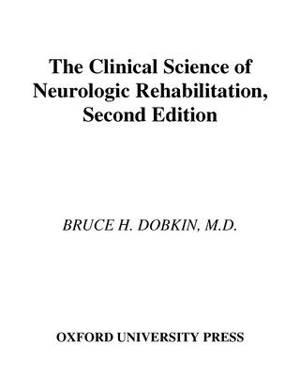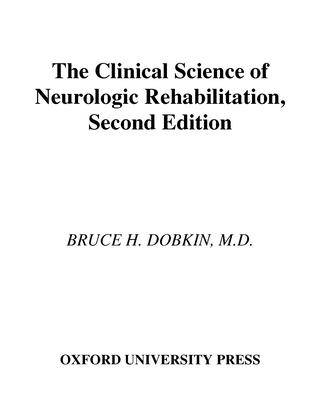
En raison d'une grêve chez bpost, votre commande pourrait être retardée. Vous avez besoin d’un livre rapidement ? Nos magasins vous accueillent à bras ouverts !
- Retrait gratuit dans votre magasin Club
- 7.000.000 titres dans notre catalogue
- Payer en toute sécurité
- Toujours un magasin près de chez vous
En raison de la grêve chez bpost, votre commande pourrait être retardée. Vous avez besoin d’un livre rapidement ? Nos magasins vous accueillent à bras ouverts !
- Retrait gratuit dans votre magasin Club
- 7.000.0000 titres dans notre catalogue
- Payer en toute sécurité
- Toujours un magasin près de chez vous
Description
The Second Edition of this single-authored volume integrates multiple disciplines of basic and clinical research to help clinicians further develop the best possible care for the rehabilitation of patients with neurologic diseases. From the readable descriptions of the structures and functions of pathways for movement and cognition, the reader comes to understand the potential for training induced, pharmacologic, and near-future biologic interventions to enhance recovery. Dr. Dobkin shows how functional neuroimaging serves as a marker for whether physical, cognitive, and neuromodulating therapies work and how they sculpt the plasticity of the brain. Themes, such as how the manipulation of sensory experience can serve as a formidable tool for rehabilitation, run throughout the text, built from the level of the synapse to behaviors such as grasping, walking, and thinking. From illustrating how we may one day repair the brain and spinal cord to how to retrain spared and new
pathways, Dr. Dobkin draws insights from a broad swath of fundamental research to give clinicians tools they can translate into bedside practices.
The book treats the medical complications and therapeutic approaches to neurologic diseases as an interconnected matrix. The management of common medical issues, impairments, and disabilities are described across diseases. Special problems posed by patients with stroke, myelopathies, brain injury, multiple sclerosis, degenerative diseases, and motor unit disorders receive individual comment. Short-term and delayed pulse interventions for patients, along with clinical trials, are dissected and put into perspective.
The First Edition of this book was titled Neurologic Rehabilitation. The title has been changed to reflect Dr. Dobkin's sense that fundamental research now drives the field of neurologic rehabilitation even more than it could in 1996 when the First Edition was published. The Second Edition features entirely new chapters on functional neuroimaging of recovery; neurostimulators and neuroprosteses; integration into the book of many new clinical and neuroscientific observations relevant to the clinician; and extensive updating and expansion of all chapters.
Readers, whether clinicians serving the rehabilitation team, or students or researchers in neuroscience, neurology, physical medicine, allied health, or bioengineering, will acquire new insights and tools for creative pursuits that aim to lessen the disabilities of patients.
pathways, Dr. Dobkin draws insights from a broad swath of fundamental research to give clinicians tools they can translate into bedside practices.
The book treats the medical complications and therapeutic approaches to neurologic diseases as an interconnected matrix. The management of common medical issues, impairments, and disabilities are described across diseases. Special problems posed by patients with stroke, myelopathies, brain injury, multiple sclerosis, degenerative diseases, and motor unit disorders receive individual comment. Short-term and delayed pulse interventions for patients, along with clinical trials, are dissected and put into perspective.
The First Edition of this book was titled Neurologic Rehabilitation. The title has been changed to reflect Dr. Dobkin's sense that fundamental research now drives the field of neurologic rehabilitation even more than it could in 1996 when the First Edition was published. The Second Edition features entirely new chapters on functional neuroimaging of recovery; neurostimulators and neuroprosteses; integration into the book of many new clinical and neuroscientific observations relevant to the clinician; and extensive updating and expansion of all chapters.
Readers, whether clinicians serving the rehabilitation team, or students or researchers in neuroscience, neurology, physical medicine, allied health, or bioengineering, will acquire new insights and tools for creative pursuits that aim to lessen the disabilities of patients.
Spécifications
Parties prenantes
- Auteur(s) :
- Editeur:
Contenu
- Nombre de pages :
- 632
- Langue:
- Anglais
- Collection :
- Tome:
- n° 67
Caractéristiques
- EAN:
- 9780195150643
- Date de parution :
- 16-01-03
- Format:
- Livre relié
- Format numérique:
- Ongenaaid / garenloos gebonden
- Dimensions :
- 257 mm x 180 mm
- Poids :
- 1462 g

Les avis
Nous publions uniquement les avis qui respectent les conditions requises. Consultez nos conditions pour les avis.






